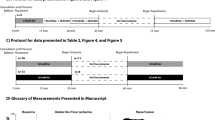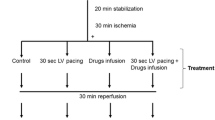Summary
The influence of perfusion pressure (5–8 kPa) on coronary flow and myocardial Ca2+-washout during Ca2+-free perfusion, and on the occurrence of calcium paradox after subsequent Ca2+-reperfusion, was studied in isolated, stimulated, rat heart ventricles.
During the Ca2+-free perfusion period (3 min) the following changes were observed: 1. Rapid cessation of ventricular contractions. 2. A pressure-dependent increase in diastolic rest tension. 3. A pressure-dependent increase in coronary flow rate. 4. A pressure-dependent increase in myocardial Ca2+-washout.
Upon Ca2+-reperfusion all hearts failed to recover fully and the incidence of complete loss of ventricular contractility (“complete calcium paradox”) increased with increasing perfusion pressure. Furthermore, a clear relationship between coronary flow and effluent-Ca2+-concentration (during Ca2+-free perfusion) and the occurrence of calcium paradox (upon Ca2+-reperfusion) was observed.
The results suggested that the processes underlying the calcium paradox mechanism are influenced by the perfusion pressure, mainly via an effect on coronary flow during the Ca2+-free perfusion phase and through this effect on the rate and extent of myocardial Ca2+-washout.
Zusammenfassung
Am isolierten, stimulierten Rattenherzventrikel wurde der Einfluß des Perfusionsdruckes (5–8 kPa) auf die Koronardurchblutung und die Ca-Ausschwemmung während der Ca2+-freien Perfusion, sowie auf das Vorkommen des “Ca2+-Paradox” (Calcium paradox) nach darauffolgender Ca2+-Reperfusion untersucht.
Während der Ca2+-freien Perfusion (3 min) waren folgende Veränderungen zu verzeichnen: 1. Ein schneller Verlust der kontraktilen Ventrikelaktivität. 2. Eine druckabhängige Zunahme der Koronarstromstärke. 3. Eine druckabhängige Zunahme der diastolischen Spannung. 4. Eine druckabhängige Zunahme der Ca2+-Ausschwemmung aus dem Myokard.
Nach der Ca2+-Reperfusion waren die Herzen nicht imstande, sich völlig zu erholen. Die Häufigkeit eines völligen Verlustes der Ventrikelkontraktilität (“complete calcium paradox”) nahm mit steigendem Perfusionsdruck zu. Außerdem wurden eine Beziehung zwischen der koronaren Stromstärke, der Ca2+-Konzentration der ausströmenden Flüssigkeit (während der Ca2+-freien Perfusionsphase) und dem Vorkommen des “Ca2+-Paradox” (nach Ca2+-Reperfusion) beobachtet.
Aufgrund der Resultate ist anzunehmen, daß die für den Mechanismus des Ca2+-Paradox verantwortlichen Prozesse durch den herrschenden Perfusionsdruck beeinflußt werden, hauptsächlich über dessen Effekt auf die koronare Stromstärke während der Ca2+-freien Perfusionsphase und damit über Geschwindigkeit und Ausmaß der myokardialen Ca2+-Ausschwemmung.
Similar content being viewed by others
References
Arnold, G., F. Kosche, E. Miessner, A. Neitzert, W. Lochner: The importance of perfusion pressure in the coronary arteries for the contractility and oxygen consumption of the heart. Pflügers Arch.299, 339–356 (1968).
Diem, K., C. Lentner: Wissenschaftliche Tabellen (Basel 1968).
Domenech, R. J., J. M. De La Prida: Mechanical effects of heart contraction on coronary flow. Cardiovasc. Res.9, 509–514 (1975).
Ganote, C. E., R. Seabra-Gomes, W. G. Nayler, R. B. Jennings: Irreversible myocardial injury in anoxic perfused rat hearts. Amer. J. Pathol.80, 419–450 (1975).
Ganote, C. E., J. Worstell, J. P. Kaltenbach: Oxygen-induced enzyme release after irreversible myocardial injury; Effects of cyanide in perfused rat hearts. Amer. J. Pathol.80, 327–350 (1975).
Guyton, A. C.: Textbook of medical physiology, 386–396 (Philadelphia 1976).
Halpern, M. H.: The dual blood supply of the rat heart. Amer. J. Anat.101, 1–16 (1957).
Hearse, D. J., S. M. Humphrey, G. R. Bullock: The oxygen paradox and the calcium paradox: Two facets of the same problem? J. Mol. Cell. Cardiol.10, 641–668 (1978).
Hearse, D. J., S. M. Humphrey, W. G. Nayler, A. Slade, D. Border: Ultrastructural damage associated with reoxygenation of the anoxic myocardium. J. Mol. Cell. Cardiol.7, 315–324 (1975).
Jennings, R. B., C. E. Ganote: Structural changes in myocardium during acute ischemia. Circ. Res.34/35, Suppl. III, 156–172 (1974).
Kloner, R. A., C. E. Ganote, D. A. Whalen, R. B. Jennings: Effect of a transient period of ischemia on myocardial cells: II. Fine structure during the first few minutes of reflow. Amer. J. Pathol.74, 399–422 (1974).
Langendorff, O.: Untersuchungen am überlebenden Säugetierherzen. Pflügers Arch.61, 291–332 (1895).
Ruigrok, T. J. C., F. J. A. Burgersdijk, A. N. E. Zimmerman: The calcium paradox: A reaffirmation. Eur. J. Cardiol.3, 59–63 (1975).
Russel, R. E., R. W. Chagrasulis, J. M. Downey: Inhibitory effect of cardiac contraction on coronary collateral blood flow. Amer. J. Physiol.; Heart Circ. Physiol.2, H541-H546 (1977).
Schaper, J., F. Herhlein, M. Schlepper, K.-U. Thiedemann: Ultrastructural alterations during ischemia and reperfusion in human hearts during cardiac surgery. J. Mol. Cell. Cardiol.9, 175–189 (1977).
Weisfeldt, M. L., N. W. Shock: Effect of perfusion pressure on coronary flow and oxygen usage of nonworking heart. Amer. J. Physiol.218, 95–101 (1970).
Whalen, D. A., D. G. Hamilton, C. E. Ganote, R. B. Jennings: Effect of transient period of ischemia on myocardial cells: I. Effects on cell volume regulation. Amer. J. Pathol.74, 381–399 (1974).
Yates, J. C., N. S. Dhalla: Structural and functional changes associated with failure and recovery of hearts after perfusion with Ca2+-free medium. J. Mol. Cell. Cardiol.7, 91–103 (1975).
Zimmerman, A. N. E., W. Daems, W. C. Hülsmann, J. Snijder, D. Durrer: Morphological changes of heart muscle caused by successive perfusion with calcium-free and calcium-containing solutions (calcium paradox). Cardiovasc. Res.1, 201–209 (1967).
Zimmerman, A. N. E., W. C. Hülsmann: Paradoxical influence of calcium ions on the permeability of the cell membranes of the isolated rat heart. Nature211, 646–647 (1966).
Author information
Authors and Affiliations
Additional information
With 6 figures
Rights and permissions
About this article
Cite this article
Koomen, J.M., Jager, L.P. & van Noordwijk, J. Effects of perfusion pressure on coronary flow, myocardial Ca2+-washout, and the occurrence of calcium paradox in isolated perfused rat heart ventricles. Basic Res Cardiol 75, 318–327 (1980). https://doi.org/10.1007/BF01907580
Received:
Issue Date:
DOI: https://doi.org/10.1007/BF01907580




